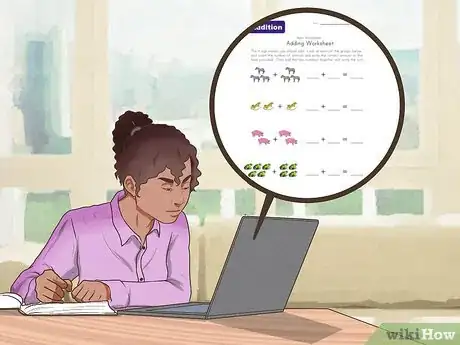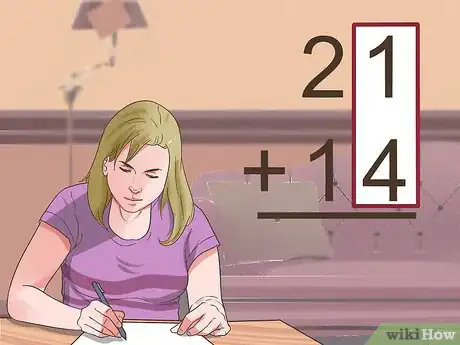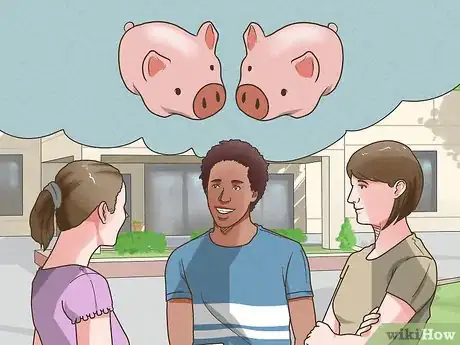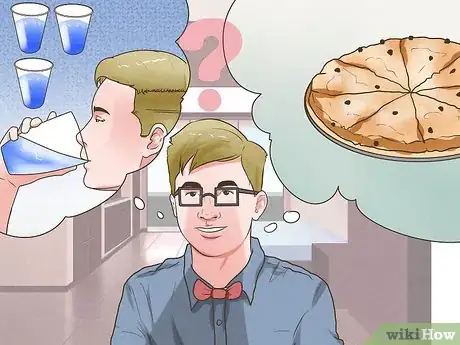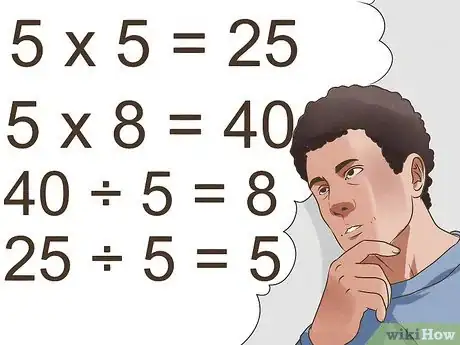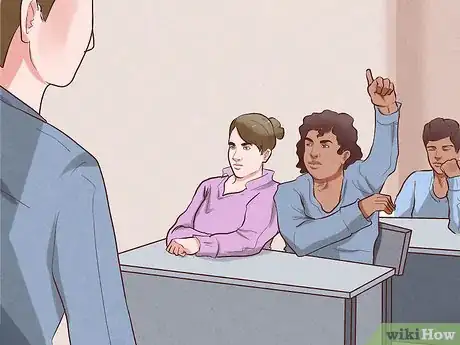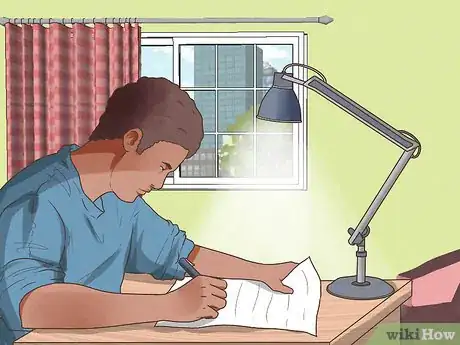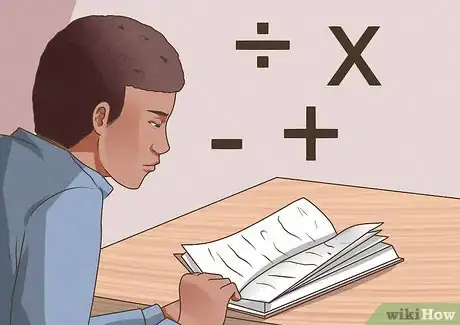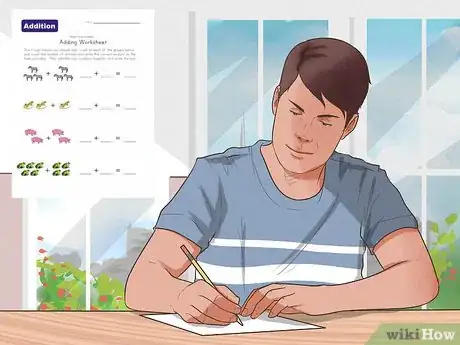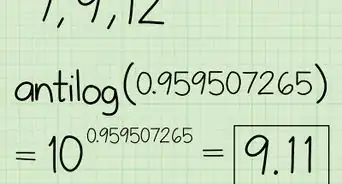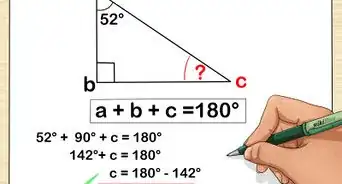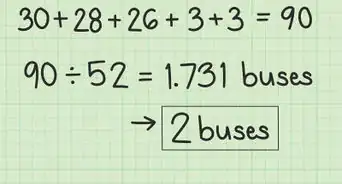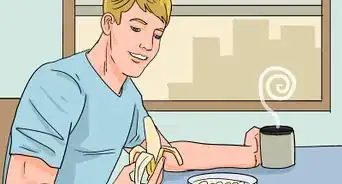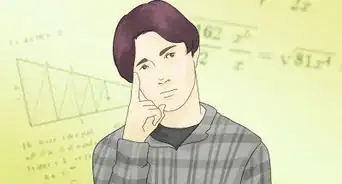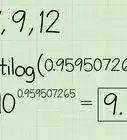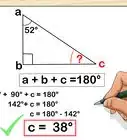This article was co-authored by Daron Cam. Daron Cam is an Academic Tutor and the Founder of Bay Area Tutors, Inc., a San Francisco Bay Area-based tutoring service that provides tutoring in mathematics, science, and overall academic confidence building. Daron has over eight years of teaching math in classrooms and over nine years of one-on-one tutoring experience. He teaches all levels of math including calculus, pre-algebra, algebra I, geometry, and SAT/ACT math prep. Daron holds a BA from the University of California, Berkeley and a math teaching credential from St. Mary's College.
There are 7 references cited in this article, which can be found at the bottom of the page.
This article has been viewed 136,641 times.
Math can be a difficult subject, but it is something that everyone is capable of mastering. Math is based on logic and rules that you can study and apply – there isn’t any special skill involved. The subject might come easier to others than you feel it does to you, but if you practice and try hard you’ll also be good at math.
Steps
Learning Addition and Subtraction
-
1Use objects to count out the math visually. Take a bag of marbles and use these to visually see how addition works. For example, take five marbles out of the bag. Now take another three marbles out of the bag. Combine all the marbles together and count how many you have. You’ll have eight marbles. That means that five plus three equals eight. [1]
- Using this tactic can help you visual subtraction too. Try taking four marbles away from your pile of eight marbles. You’ll end up with four marbles left. That means that eight minus four equals four.
-
2Practice your addition and subtraction tables. [2] You can buy workbooks online or visit free websites that allow you to practice. You’ll be presented with a table filled with all sorts of problems to solve – everything from one plus one to seventeen plus fifteen and so on. [3]Advertisement
-
3Start by adding the final digits of both numbers together. If you are adding numbers that have multiple digits you can set them up on top of each other to make it easier to add. Consider the problem 21 plus 14. Draw the equation so that the 21 is sitting on top of the 14. Now draw a line underneath the 14. Adding down, add the final two numbers. In this case, those numbers would be the ‘1’ from 21 and the ‘4’ from 14. [4]
- One plus four equals five, so you would write a five below the line you made under those two numbers. Now add the ‘2’ from 21 and the ‘1’ from 14. Two plus one equals three. Write the three under those two numbers to the left of the five that you just wrote. You should have the numbers 3 and 5 sittings next to each other below the line you drew. That means the answer to this problem is 35. 14 + 21 = 35.
- If you add two numbers together and they make another two digit number, take the one from that two digit number and move it over to the left. For example, if the problem was 14 + 28 instead your first calculation would be 8 + 4. This would give you 12. You would still put the ‘2’ from 12 below the line underneath the 4 and the 8. However, the ‘1’ from 12 would then be moved over to the left and added to the second equation. So you would add the ‘1’ from 14, the ‘2’ from 28 and the ‘1’ from 12. That would give you the number 4 once you add all those numbers together. This means that 14 + 28 must equal 42.
-
4Play games with simple math.[5] Pass the pigs is a popular game that has you roll tiny ceramic pigs on a table. Based on the way that they land, you earn a certain amount of points. You only play to 100 so the numbers never get too high, but it’s a great way to learn basic addition. It’s much better than doing addition tables for hours!
Learning Multiplication and Division
-
1Understand the concept of multiplication and division. The idea behind multiplication is to shortcut adding the same things over and over again. You use multiplication when you have groups of the same size. For example, maybe you have three cups of water that you drank ten times. How many cups of water did you drink total? You could solve this problem by counting adding the amount of times you drank the water from each cup together, or you could clump them into groups to multiply. [6]
- The idea behind division is splitting equal parts into groups. If you have a pizza with eight slices and four friends, how should you split it up so that each person gets an equal amount of the pizza? In division, that problem would be written as eight divided by four. Each person gets two pieces of pizza.
-
2Learn the properties of multiplication. For example, order doesn’t matter when you multiply. That’s one of the properties that you should learn if you want to learn multiplication. You also should learn multiplication problems that change the order of factors, which is called commutativity, problems that change the grouping of factors, which is called associativity.[7]
-
3Practice your multiplication and division tables. Becoming familiars of the rules to each number will be a huge help when dividing and multiplying. For example, when you multiple numbers by five the answer will always end in a five or a zero. If you multiply a number by two, it will always end in an even number. Similar rules apply for division. Learn these rules and practice your tables.
Being a Good Student
-
1Pay attention in class. You'll never learn mathematics if you don't know the basics. Make sure you pay particular attention at the start of each new unit as things are explained. Math is generally taught as a series of building blocks and if you miss a block it could be very difficult to catch up.
-
2Take notes. If you take notes in class you'll be able to look back on what you did in class that day. When you go to do your homework you’ll be able to refer back to the examples that you wrote down from class. Make sure you write down each individual step needed to solve a problem, or else you might get stuck in your work.[8] Writing as you learn also helps you learn and remember better. [9]
-
3Study. Studying before the test is always going to be necessary, but there’s nothing wrong with taking fifteen or twenty minutes every night to study the lesson that you learned that day. You’ll find that you feel much more prepared for the following day of class and you will do less cramming the day before the test.
-
4Answer questions and ask question in class. It doesn't matter if you get the answer wrong, at least you tried and don't feel ashamed by asking questions.[10] How do you know you might ask somebody else's question, they might be thankful and probably help you out on bits you don't understand.
-
5Do your homework. Working on math everyday is the real key to understanding it. The more time you spend around the number and concepts the more comfortable you will be with them. Homework might seem like a drag but the daily repetition will really help you. [11]
Searching for Help
-
1Go for extra help. Almost any teacher will go to extra help. Don’t be too proud to ask – you’ll develop a relationship with your teacher and it will help a lot. Your teacher will appreciate that you came in looking for more help and the teacher will know what you need to work on in the future. This is highly recommended.
-
2Practice more on your own.[12] You have to be honest with yourself here. Is the issue that you aren’t trying hard enough, or that you really just don’t understand math? If you’re not trying hard enough, you need to work harder to practice on your own. There’s no way to understand math if you aren’t willing to put in the work. However, if you have been practicing on your own and you just can’t wrap your head around a certain subject, then it’s perfectly logical to ask for help.
-
3Hire a tutor.[13] If you’re willing to spend money, hiring a professional tutor can be a huge help when it comes to understanding a subject. Professional tutors are often very expensive, but if you hire an older student the price might come down. Tutors will sit down with you one on one and work you through your problems.
-
4Look to a friend or peer for guidance. If you don’t want to hire a tutor or go to extra help another good option is to ask a peer. There is bound to be someone in the math class who understands the concepts well. Find this person and develop a relationship with them. Ask them if they would be willing to sit down with you over lunch and help you with a couple of topics you are struggling with. Don’t take advantage of them and never try to copy their answers – just use them as a resource. There’s no reason to be too proud to ask for help. That’s a good skill to develop in life.
Practicing
-
1
-
2Use mathematics in everyday life. When you're getting the change in the supermarket calculate how much money you should get back. If you are buying gas at a gas station, try to multiply the price by the amount of gallons it takes to fill your tank. Getting better at mental math is a great way to feel more confident, even if the subjects you are studying in school are much more complex. You will always be using addition, subtraction, and multiplication in one way or another no matter how complicated the subject gets.
-
3Focus on specific topics. Math is a broad field. Unless you devote your life to the studying of mathematics it is unlikely that you’ll ever understand everything. Figure out what part of math is most important for you to understand. Maybe it’s something you’re studying in school or a subject you have a personal interest in. Start with the basics and work your way up. Don’t start trying to do algebra if you aren’t comfortable with your multiplication tables yet.
-
4Buy a practice book. You can find practice books on the Internet or in bookstores for any math topic imaginable. These practice books will have a guided curriculum to help you get better at math.
-
5Test yourself. Testing yourself is a great way to figure out for sure what you understand and what you don’t understand. You might think you understand a concept but you won’t really know for sure until you test yourself. Most textbooks feature practice questions and tests.
-
6Stay committed. Like anything else, being good at math takes a lot of practice. You wouldn’t expect to be muscular after doing twenty pushups at the gym, so you shouldn’t expect to be good at math after doing twenty practice problems. Practice everyday and you’ll start to understand math more and more.
Expert Q&A
Did you know you can get expert answers for this article?
Unlock expert answers by supporting wikiHow
-
QuestionHow do I get help for math?
 Daron CamDaron Cam is an Academic Tutor and the Founder of Bay Area Tutors, Inc., a San Francisco Bay Area-based tutoring service that provides tutoring in mathematics, science, and overall academic confidence building. Daron has over eight years of teaching math in classrooms and over nine years of one-on-one tutoring experience. He teaches all levels of math including calculus, pre-algebra, algebra I, geometry, and SAT/ACT math prep. Daron holds a BA from the University of California, Berkeley and a math teaching credential from St. Mary's College.
Daron CamDaron Cam is an Academic Tutor and the Founder of Bay Area Tutors, Inc., a San Francisco Bay Area-based tutoring service that provides tutoring in mathematics, science, and overall academic confidence building. Daron has over eight years of teaching math in classrooms and over nine years of one-on-one tutoring experience. He teaches all levels of math including calculus, pre-algebra, algebra I, geometry, and SAT/ACT math prep. Daron holds a BA from the University of California, Berkeley and a math teaching credential from St. Mary's College.
Academic Tutor
-
QuestionHow can I get better at the basics?
 DonaganTop AnswererAsk someone to tutor you in the basics and do practice problems on your own.
DonaganTop AnswererAsk someone to tutor you in the basics and do practice problems on your own. -
QuestionHow do I study math when I have an exam in two days?
 Community AnswerRead all of the rules and go over your notes. Then do questions from each concept to check that you understand how to do each type of problem.
Community AnswerRead all of the rules and go over your notes. Then do questions from each concept to check that you understand how to do each type of problem.
References
- ↑ https://www.mathsisfun.com/numbers/addition.html
- ↑ http://www.mathworksheetscenter.com/mathtips/learningaddtion.html
- ↑ http://www.kidslearningstation.com/math/addition-worksheets.asp
- ↑ http://www.mathworksheetscenter.com/mathtips/learningaddtion.html
- ↑ Daron Cam. Academic Tutor. Expert Interview. 29 May 2020.
- ↑ https://www.khanacademy.org/math/arithmetic/multiplication-division
- ↑ https://www.khanacademy.org/math/arithmetic/multiplication-division
- ↑ Daron Cam. Academic Tutor. Expert Interview. 29 May 2020.
- ↑ http://www.math.utah.edu/~pa/math.html
- ↑ Daron Cam. Academic Tutor. Expert Interview. 29 May 2020.
- ↑ http://www.math.utah.edu/~pa/math.html
- ↑ Daron Cam. Academic Tutor. Expert Interview. 29 May 2020.
- ↑ Daron Cam. Academic Tutor. Expert Interview. 29 May 2020.
- ↑ Daron Cam. Academic Tutor. Expert Interview. 29 May 2020.
- ↑ http://www.math.utah.edu/~pa/math.html
- ↑ https://betterexplained.com/articles/thinking-about-zero/

